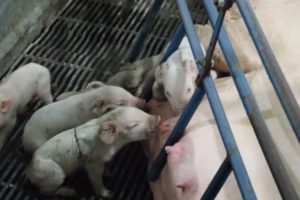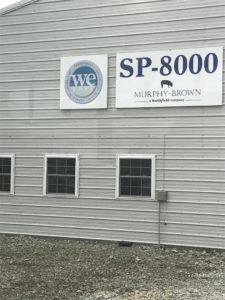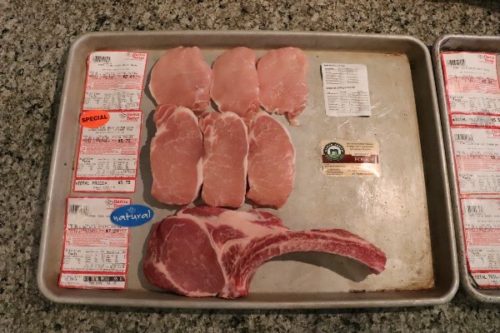*See disclosure at end
I know it sounds like the start of a bad joke, but it’s true. I’m a Jewish dietitian, and I just came back from visiting a pig farm. Growing up, pork was not a regular part of my diet because according to Jewish law, it’s not kosher. Except for bacon, because my mom said it doesn’t count. (Sorry, mom, you’ve been outed, but I can’t fault you. Bacon is delicious.)

Then I married a man from southern Illinois who was an active member of 4-H and FFA and raised pigs to show at the county fair. Let’s just say that pork has always been a major food group in his diet. Meanwhile, I can count on one hand the number of times in my life that I’ve had ham. And until just a few days ago, I’d never had a pork chop.
So when I was offered the opportunity to tour a Smithfield pig farm in North Carolina* to learn how they’re raised and make it to the plate, I jumped at the chance. Side note: My husband suggested that I write “squealed with excitement.” Dad joke!
Anyway. As a registered dietitian, it’s important to be able to answer people’s questions about all kinds of food — even the ones I don’t choose to eat regularly. Plus, I had questions of my own. What’s a “factory farm” really like? How are the animals treated? How sustainable is animal agriculture? And, of course, are piglets as cute in person as they are in the movies? (See: Babe (1995), Babe: Pig in the City (1998), Charlotte’s Web (2006), etc.)
Since I came in with virtually no knowledge about pig farming, I obviously learned a LOT, but I wanted to share my top takeaways — no cheesy
punchline at the end, I promise!
- “Factory farming” is not what you think.
There is a certain romance to the idea of pasture-raised pork, I admit, but that was before I learned that pigs have a natural instinct to root around and if left to their own devices, they can tear up the ground and cause a lot of damage. Yikes! Still, I thought maybe it would be worth it for a better quality of life compared to being raised indoors.

Touring the farm and seeing it for myself totally changed my perspective. I was surprised at how clean the facilities were, all things considered — I mean, it was a pig farm, after all. Yes, there were a lot of animals housed in a relatively small space, but I didn’t see any pigs that appeared to be stressed. In fact, farmers do everything they can to make sure that the pigs are NOT stressed because it affects the quality of the meat. They have access to water at all times and the barns have cooling systems to maintain a comfortable temperature. Pasture-raised pigs might not always have it that good. My husband was just griping to me that his dad used to wake him up at 4:30 am to go “hose down his hogs” and keep them cool!
Keeping pigs indoors also has an advantage in terms of food safety. Trichinosis, a foodborne illness associated with undercooked pork, is caused by a parasite in the soil that pigs ingest outside. Hence, raising pigs in barns pretty much eliminates this problem. On the downside, soil
contains iron; newborn pigs are born with low iron reserves and sows’milk is low in the mineral, so they receive an iron injection to prevent anemia. This doesn’t sound like an ideal situation, but I’d argue it’s not much different than humans taking supplements to fill nutritional gaps.
This leads me to my next point…
- Farmers are serious about the health and safety of their animals.

That “no trespassing” sign might make you wonder what’s going on behind closed doors, but it’s there for a reason — to keep you and your germs out. Before entering the farm, we had to answer biosecurity questions to make sure we hadn’t been around other pigs recently or traveled to foreign countries. We also had to take a full shower and change into a fresh work jumpsuit and boots before going into the barns — the “clean” side — and take a full shower again before changing back into our street clothes on the “dirty” side. All of this is to protect the pigs from contracting potentially life-threatening illnesses and prevent having to use antibiotics.
Speaking of which…
- Antibiotics are used extremely carefully and no hormones are EVER added to pork!
I was shocked at the rigmarole farmers must go through to treat their animals with antibiotics (which is a good thing). A veterinarian must fill out a Veterinary Feed Directive (VFD) that is very specific and includes such details as the dosage, length of antibiotic course, withdrawal time, and more. They certainly are not throwing antibiotics at all of their pigs. Farmers do everything in their power to prevent the pigs from getting sick in the first place, and if they do, they are treated under the care of a veterinarian.

How about packaged pork that screams “NO HORMONES EVER”?
This implies that some pork products do have added hormones, but you just need to look to the Food Safety and Inspection Service of the USDA to learn that added hormones in pork is not a thing:
Hormones are not allowed in raising hogs or poultry. Therefore, the claim “no hormones added” cannot be used on the labels of pork or poultry unless it is followed by a statement that says “Federal regulations prohibit the use of hormones.”
All of this talk about animal welfare is typically wrapped up with concerns about sustainability. This leads me to the last point.
- Sustainability is integrated throughout pig farming operations.
 One farmer that I met, Jan Archer, raises pigs and grows hay. The hay goes down the road to a goat farm to feed them. The goats produce milk, which is turned into goat cheese from the curds. The drained whey is returned back to Jan’s farm to feed her pigs.
One farmer that I met, Jan Archer, raises pigs and grows hay. The hay goes down the road to a goat farm to feed them. The goats produce milk, which is turned into goat cheese from the curds. The drained whey is returned back to Jan’s farm to feed her pigs.
At the Smithfield farm, I observed the pigs’ waste being drained from the barns to a lagoon, where it is broken down by bacteria and turned into a nutrient-rich fertilizer for plant crops, which are then turned into feed for the pigs.
(Cue “Circle of Life” music!)
These kinds of practices maximize efficiency and minimize the use of additional resources, which helps protect the environment and lowers food costs. If that’s not sustainability, I don’t know what is.

To wrap it up, there’s a lot more to pig farming than I ever could have imagined. After the tour, I feel much better prepared to answer consumer questions and I can say without reservation that I have full confidence in the safety and quality of pork — from farm to fork.
Oh, and piglets are just as cute as I thought they would be.
______________________________________
Have questions beyond what I covered in this post? Comment below!
If I can’t answer your question, I might point you in the direction of Peggy Greenway and/or Wanda Patsche. Both Peggy and Wanda are rockstar farmers with years of knowledge and experience. You can also feel free to reach out to them directly! They love to talk with consumers.
Peggy is @GreenwayPork on Twitter
Wanda is @MNFarmLiving on Twitter, Minnesota Farm Living on Facebook, and she blogs at http://www.mnfarmliving.com/
I also highly recommend visiting the Pork Checkoff for more information about their We Care (SM) initiative, a collaboration between the National Pork Board, the National Pork
Producers Council (NPPC) and state organizations representing farmers.
We Care is a proactive, multifaceted initiative to promote responsible
practices in all areas of farming and is a commitment to continuously
evaluate and improve our methods.
You can also find scores of pork recipes, nutrition information, cooking tips, and more at http://www.pork.org!
Note: This post was originally published on Medium.com, 6/19/18.
Disclosure: My travel was sponsored by the NC Pork Council, National Pork Board, National Pork Producers Council, Pork Checkoff, and Smithfield Foods. No compensation was received for this post. All opinions are completely my own.

